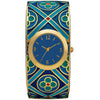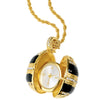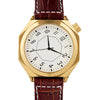Art Watches
See the Watch Shop for Men's Watches & Ladies' Watches
American Tip Top Watch, Gold Overlay with Brown Strap
In a remarkable piece of advertising hyperbole in the March 1931 edition of Boy’s Life magazine, an advertisement for Tip Top watches appears. It ran: ‘That shifty Quick-change Artist MR. TEMPERATURE can “play the devil” with watch accuracy. But Tip Top Watches defy heat and cold because they are compensated for temperature changes. TIP-TOP JR. WRIST-WATCH with genuine chromium-plated metal-mesh strap and case $5.00. With leather strap $4.50. Either with radium dial, 50¢ extra. Raised numerals on silver dial. Krack-proof Krystal.’
It went on: ‘What happens to a watch that you carry from a warm room to a cold street? Or to a watch that snuggles to your wrist by day and then shivers all night in your cold bedroom? Temperature changes are the old enemy of watch-accuracy – making a watch run faster in cold and slower in heat – unless the watch has the fine feature of compensation for temperature changes. This feature that you’d insist on if buying an expensive watch has now actually been embodied in a low-priced watch and it has been proven in U.S. Bureau of Standards tests that this feature reduces, to a negligible degree, all possible time-variations from heat or cold. At only $5 Tip-Top Jr. Wrist-watch gives you this compensation for temperature changes, assuring a character of timekeeping dependability worthy of Tip-Top Jr.’s beauty of design. Tip-Top pocket watches, too, as low as $1.50 have these same remarkable features. Ask for Tip-Top.
The New Haven Clock Co., New Haven, Conn., Watch Division, Tip-Top Watches'
One realises that, in the 1930s, people obviously relied on the written word, accompanied, by sketches, perhaps, for the bulk of their information. The thrust of the copy is the solid virtues of dependability and punctuality. After all, if one’s timepiece is inaccurate, how can one be on time! There’s only the slightest appeal here to glamour or status. Nevertheless, the New Haven Clock Company’s Tip Top Watch was a good looker.
According to Collectors Weekly, the New Haven Clock Company was founded in 1853 and was the first firm to mass-produce brass clock movements.
The Antique Clocks Price Guide picks up the story. The company was incorporated on February 7, 1853 in New Haven, Connecticut by Hiram Camp (1811 – 1892) and a number of others. Its operations were meant to supply brass clock movements to the Jerome Manufacturing Company run by Camp’s uncle Chauncy Jerome. The Jerome Manufacturing Company had been founded just three years previously in 1850 but Chauncy Jerome had been in the watch-making business since before 1816 and had had enormous success. By the time he formed the Jerome Company, Chauncy was producing over 400,000 clocks and other timepieces. But then disaster struck. He partnered with the famous showman Phineas Taylor Barnum (P T Barnum) in a disastrous venture to develop East Bridgeport in Connecticut. Both Barnum and Chauncy suffered heavy financial losses. As a result, the Jerome Manufacturing Company went bankrupt and was acquired by the New Haven Clock company.
In 1915, the New Haven Clock Company began producing wrist watches for men and, a little later, wrist watches for women. And continued to do so until it went out of business in 1960. Their Tip Top watches were first made in the 1920s. The Tip Top dollar pocket watch has a design patent date printed at the top of the edge of the dial displays of 1926. It is more than likely that the wrist-watch patent precedes that. American Tip Top Watch, Gold Overlay with Brown Strap
See also American Tip Top Watch, Silver Overlay with Black Strap
Egyptian Princess Beaded Watch
A watch with a design taken from a beaded pectoral belonging to Princess Sit-hathor-yunet who lived some 1,800 years before the birth of the Christ.
The pectoral, discovered in a niche of the princess’ tomb, is of gold with veneers of carnelian, feldspar, garnet and turquoise, interwoven in the body. Since the tomb was constructed alongside the mud-brick pyramid at el-Lahun bearing the remains of Senwosret II, it’s very likely the princess stood in some special relationship to the king. There is speculation she may have been his daughter.
The pectoral is crafted using the ancient technique known as cloisonné. This refers to inlaying gemstones or other material over metal objects. The name derives from the French for compartments. The technique involves marking out areas or compartments on the surface to which the inlays will be applied. This pectoral is inlaid with 372 separate pieces of gemstone. The symbols employed in the design are highly significant. They represent the titularies of the king. Egyptian rulers were given five such nomens or titularies.
The first and oldest titulary was the Horus-name, also referred to as the banner-name or Ka-name. This title indicated that the king was the earthly representative of the falcon god, Horus. There was, also, another titulary known as the Golden-Horus-name. Thus, the two standing falcons forming the outsides of the pendant may, most likely, represent this falcon god. In some accounts of the birth of Horus, he is said to be the son of the sun god Ra or Re. This connection leads on the hieroglyph borne by the two falcons which means ‘to encircle’. The sign is a reminder of the sun’s power over the Egyptian universe. The same hieroglyph has been modified to form an oval called a shenu or cartouche which encloses another of the king’s titularies: the prenomen or throne-name. This was the title granted at coronation. Within the cartouche is the nomen Khai-kheper-re, which is the throne name of Senwosret II. Both the prenomen or throne name and the nomen or birth-name had strong associations to the sun god Ra.
On either side of the cartouche are two ankhs representing eternal life. They are attached to two serpents whose tails wind around the hieroglyphic disks borne by the falcons. These two serpents represent the Nebti-name or the ‘He of the two ladies’ nomen. The two ladies referred to are the vulture-goddess Nekhbet and the cobra-goddess Udjo or Uto. Under the cartouche, the god Am-heh, whose name means 'the devourer of millions', sits.
‘Jewelry worn by royal women during the Middle Kingdom was not simply for adornment or an indication of status but was also symbolic of concepts and myths surrounding Egyptian royalty. Jewelry imbued a royal woman with superhuman powers and thus enabled her to support the king in his role as guarantor of divine order on earth. It was essentially the king who benefited from the magical powers inherent in the jewelry worn by the female members of his family, which explains why his name, rather than that of the princess, appears in the designs.
Since the tomb of the princess was beside the pyramid of Senwosret, scholars speculate that she was his daughter. Other items in the tomb bear the name of Amenemhat III, suggesting that the princess lived during the reigns of three of the most powerful rulers of Dynasty 12: Senwosret II, Senwosret III, and Amenemhat III.’ MET
17th-century English Men’s Watch

The original on which this watch is modelled was made in 1682 or 1683. It combined two of the main movement technologies existing at that time, i.e. a spring balance and a fusee. The design of its dial belies its four-hundred-year-old age. It could fit in, unnoticeably, in a display of modern watches. It has two chapter-rings. The first marks off the hours in Roman numerals and the minutes in Arabic ones. The second chapter-ring is a smaller one positioned just above 6 o’clock that count the seconds. This innovative timepiece has separate, concentrically-mounted hands for the hours and minutes. All the numerals are black and they stand out clearly from the golden colour of the dial. The outer case is made of leather, studded with gold pins. The inner case and champlevé dial are of gold. Champlevé is a enameling technique or an object to which the technique has been applied. It involves carving out troughs or depressions in a metal plate and pouring hot enamel in. The movement is a verge escapement which is signed. The diameter of the piece is 2½ inches.
Watch movements in the 17th-century consisted, essentially, of three major components: a spring, geared wheels, and an escapement. The motive force for the entire apparatus was the uncoiling of the wound spring. But this presented a challenge since the force diminished as the spring unwinded. To solve this problem, a clever device called a fusee was interposed between the spring and the train of wheels. The fusee is shaped like a cone and its surface is channeled with a groove along which a line of cat gut or chain is threaded. This line is attached at one end to the spring barrel and at the other to the fusee. As the spring unwinds, the line unravels from the (narrower) top of the cone so that it, progressively, runs around an increasing diameter. This increasing diameter compensates for the decreasing tension of the spring and, thus, maintains an even torque. See here for a look at a fusee.
Thomas Tompion was born in England in 1639. His father was a blacksmith and it may have been this circumstance that led the young Tompion to sign up as an apprentice in the Worshipful Company of Clockmakers at the age of 32. There are no extant records of his life up until that point. He ‘graduated’ three years later, in 1674, as a journeyman. And, in 1676, was appointed to the newly established Royal Greenwich Observatory. He eventually rose to the rank of master.
Tompion was fortunate to come to the attention of two influential figures. The first was Robert Hooke, the renowned polymath, who had been appointed, in 1662, as the Curator of Experiments for the recently formed Royal Society (1660). The other was Sir Jonas Moore, Surveyor-General of Ordnance at the Tower of London. Through these two Tompion was introduced to society. He succeeded so well that he won the favour of Charles II for whom he made a balance-spring watch.
Tompion was one of the first to adopt the spiral spring balance that had been invented in 1675 by the renowned Dutch mathematician Christiaan Huygens (1629 – 1695). Indeed at first, he sought to dispense with the fusee altogether, relying only on the spring. But the resulting timekeeping accuracy was poor and so the fusee was incorporated with Huygens’ spring balance. He did come up with a regulator sometime between 1674 and 1675 that could be adjusted to slow a fast timepiece or speed up a tardy one. He was also the first, in 1695, to use horizontal escapement.
He made timepieces that include a turret clock for the Tower of London (no doubt a commission through Jonas Moore) and pieces for Charles II, William III, and Mary II and Cosimo III, Duke of Tuscany.
See the Watch Shop for more delightful art timepieces.






